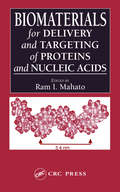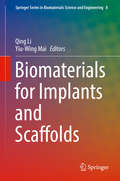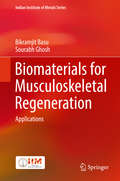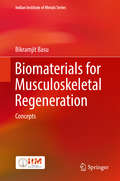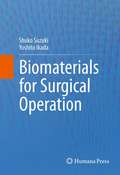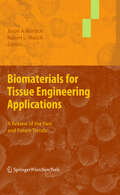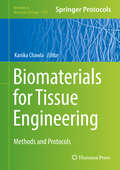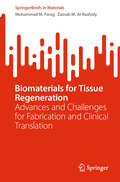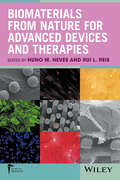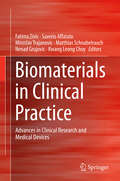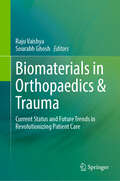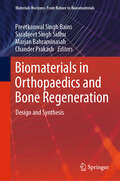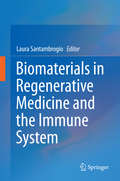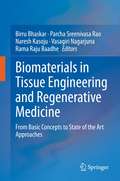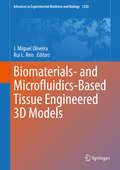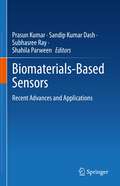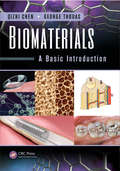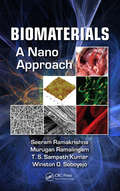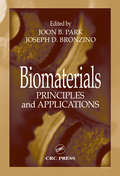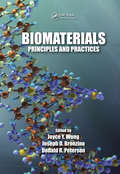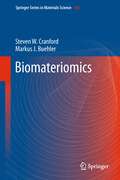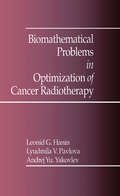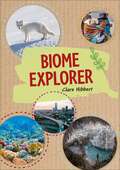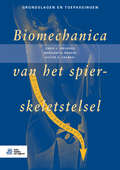- Table View
- List View
Biomaterials for Delivery and Targeting of Proteins and Nucleic Acids
by Ram I. MahatoNewcomers to the field of biopharmaceuticals require an understanding of the basic principles and underlying methodology involved in developing protein- and nucleic acid-based therapies for genetic and acquired diseases.Introducing the principles of polymer science and chemistry, this book delineates the basic biology required for understanding how biomaterials can be used as drug-deliver vehicles. No book to date combines a discussion of high-tech biomaterials-based delivery of protein and nucleic acid drugs with the pharmaceutical or biocompatibility aspects. Leading experts from around the world discuss the physiochemical parameters used for design, development, and evaluation of biotechnological dosage forms for delivery of proteins, peptides, oligonucleotides, and genes. The book includes coverage biological barriers to extravasation and cellular uptake of proteins and nucleic acids.
Biomaterials for Implants and Scaffolds (Springer Series in Biomaterials Science and Engineering #8)
by Qing Li Yiu-Wing MaiThis book highlights the latest, cutting-edge advances in implantable biomaterials. It brings together a class of advanced biomaterials in two highly active research areas, namely implants and tissue scaffolds, to underline their respective functional requirements for further development. It is unique in providing a full range of methodological procedures, including materials syntheses, characterisation, cellular tests and mathematical modelling. Covering metallic, ceramic, polymeric and composite materials commonly used in biological applications and clinical therapeutics, it is a valuable resource for anyone wanting to further their understanding of the latest developments in implantable biomaterials. Focusing on biomedical applications in implants and scaffolds, it provides methodological guides to this rapidly growing field. Qing Li and Yiu-Wing Mai are both professors at the University of Sydney School of Aerospace, Mechanical and Mechatronic Engineering.
Biomaterials for Musculoskeletal Regeneration: Applications (Indian Institute of Metals Series)
by Bikramjit Basu Sourabh GhoshThis book discusses a number of case studies to showcase the translation of research concepts to lab-scale materials development for biomedical applications. The book intends to motivate active researchers to develop new generation biomaterials. This book is meant for readers, who are already familiar with the broad area of biomaterials. The book introduces readers to the field of additive manufacturing of biomaterials and teaches them how to extend this innovative processing approach to a variety of biomaterials for musculoskeletal applications. It covers both in vitro and in vivo biocompatibility and toxicity assessment for a broad range of biomaterials in the context of bone tissue engineering. It works to sensitise researchers in the field of translational biomedical engineering on the importance of clinical trials and discusses the challenges ahead in this important field of research. This book will be useful to clinicians, professionals and researchers alike.
Biomaterials for Musculoskeletal Regeneration: Concepts (Indian Institute of Metals Series)
by Bikramjit BasuThis book covers the basics of the biomaterials science its applications to bone tissue engineering. The introductory section describes the most necessary concepts and techniques related to the cell and molecular biology with a particular focus on evaluating the biocompatibility property. The layout of this book facilitates easier understanding of the area of bone tissue engineering. The book integrates the Materials Science and Biological Science. It covers processing and basic material properties of various biocompatible metals and ceramics-based materials, in vitro and in vivo biocompatibility and toxicity assessment in the context of bone tissue engineering, and processing and properties of metal-, ceramic- and polymer-based biocomposites, including the fabrication of porous scaffold materials. The book can be used as a textbook for senior undergraduate and graduate coursework. It will also be a useful reference for researchers and professionals working in the area.
Biomaterials for Surgical Operation
by Yoshito Ikada Shuko SuzukiBiomaterials for Surgical Operation offers a review of the latest advances made in developing bioabsorbable devices for surgical operations which include surgical adhesives (sealants), barriers for the prevention of tissue adhesion, polymers for fractured bone fixation, growth factors for the promotion of wound healing, and sutures. Over the years, many descriptions of biomaterials have appeared in academic journals and books, but most of them have been devoted to limited clinical areas. This is in marked contrast with this volume which covers a wide range of bioabsorbable devices used in surgery from a practical point of view. The currently applied polymeric devices are critical in surgery, but all involve serious problems due to their poor performance. For instance, fibrin glue, the most widely used surgical sealant, can produce only a weak gel with low adhesive strength to tissues, accentuating the limited effectiveness of current treatment options. Likewise, the currently available barrier membranes cannot fully prevent tissue adhesion at the acceptable level and are, moreover, not easy to handle with endoscopes due to their poor mechanical properties. Biomaterials for Surgical Operation is aimed at those who are interested in expanding their knowledge of how the problems associated with the currently used devices for surgical operation can be solved. It primarily focuses on the absorbable biomaterials which are the main components of these medical devices.
Biomaterials for Tissue Engineering Applications: A Review of the Past and Future Trends
by Robert L. Mauck Jason A. BurdickA concise overview of tissue engineering technologies and materials towards specific applications, both past and potential growth areas in this unique discipline is provided to the reader. The specific area of the biomaterial component used within the paradigm of tissue engineering is examined in detail. This is the first work to specifically covers topics of interest with regards to the biomaterial component. The book is divided into 2 sections: (i) general materials technology (e.g., fibrous tissue scaffolds) and (ii) applications in the engineering of specific tissues (e.g., materials for cartilage tissue engineering). Each chapter covers the fundamentals and reflects not only a review of the literature, but also addresses the future of the topic. The book is intended for an audience of researchers in both industry and academia that are interested in a concise overview regarding the biomaterials component of tissue engineering, a topic that is timely and only growing as a field.
Biomaterials for Tissue Engineering: Methods And Protocols (Methods In Molecular Biology #1758)
by Kanika ChawlaThis volume provides protocols for the generation of various biomaterials for tissue engineering and regenerative medicine applications. The chapters in this book include a look at a range of biomaterials including hydrogels and other matrices (natural, synthetic, self-healing) for various applications including drug and gene delivery, surface modification and functionalization of biomaterials. In addition, techniques described include those for controlling biomaterial geometry, such as three-dimensional printing and electrospinning. Written in the highly successful Methods in Molecular Biology series format, chapters include introductions to their respective topics, lists of the necessary materials and reagents, step-by-step, readily reproducible laboratory protocols, and tips on troubleshooting and avoiding known pitfalls.Cutting-edge and thorough, Biomaterials for Tissue Engineering: Methods and Protocols is a valuable resource for scientists and engineers interested in this vital field of study.
Biomaterials for Tissue Regeneration: Advances and Challenges for Fabrication and Clinical Translation (SpringerBriefs in Materials)
by Mohammad M. Farag Zainab M. Al-RashidyThis book comprehensively reviews the essential characteristics of biomaterials and their designs important for applications in tissue regeneration. It delves into both past research milestones in tissue engineering and emerging trends poised for future integration. The primary focus lies on the evolution of biomaterial generations and the burgeoning domain of tissue engineering discovery. Furthermore, it examines various biomaterial categories, including bioceramics, bioactive glasses, synthetic and natural polymers, alongside their composite derivatives, all pivotal in scaffold fabrication, a cornerstone of tissue engineering. The book also looks at diverse scaffold fabrication methodologies, providing readers with a thorough understanding of the technical intricacies involved. The book showcases recent breakthroughs in tissue engineering across multiple fronts such as bone, skin, cartilage, neural, and cardiac regeneration, highlighting their potential as pre-clinical interventions for rehabilitating injured or diseased tissues and organs. Finally, it reviews the contemporary landscape of biomaterials for tissue regeneration, shedding light on emerging trends and confronting the challenges that lie ahead.
Biomaterials from Nature for Advanced Devices and Therapies
by Nuno M. Neves Rui L. ReisIn-depth information on natural biomaterials and their applications for translational medicine! Undiluted expertise: edited by world-leading experts with contributions from top-notch international scientists, collating experience and cutting-edge knowledge on natural biomaterials from all over the world A must-have on the shelf in every biomaterials lab: graduate and PhD students beginning their career in biomaterials science and experienced researchers and practitioners alike will turn to this comprehensive reference in their daily work Link to clinical practice: chapters on translational research make readers aware of what needs to be considered when a biomaterial leaves the lab to be routinely used
Biomaterials in Clinical Practice: Advances in Clinical Research and Medical Devices
by Fatima Zivic Nenad Grujovic Saverio Affatato Miroslav Trajanovic Matthias Schnabelrauch Kwang Leong ChoyThis book covers the properties of biomaterials that have found wide clinical applications, while also reviewing the state-of-the-art in the development towards future medical applications, starting with a brief introduction to the history of biomaterials used in hip arthroplasty. The book then reviews general types of biomaterials - polymers, ceramics, and metals, as well as different material structures such as porous materials and coatings and their applications - before exploring various current research trends, such as biodegradable and porous metals, shape memory alloys, bioactive biomaterials and coatings, and nanometals used in the diagnosis and therapy of cancer. In turn, the book discusses a range of methods and approaches used in connection with biomaterial properties and characterization - chemical properties, biocompatibility, in vivo behaviour characterisation, as well as genotoxicity and mutagenicity - an d reviews various diagnostic techniques: histopathological analysis, imagining techniques, and methods for physicochemical and spectroscopic characterization. Properties of stent deployment procedures in cardiovascular surgeries, from aspects of prediction, development and deployment of stent geometries are presented on the basis of novel modelling approaches. The last part of the book presents the clinical applications of biomaterials, together with case studies in dentistry, knee and hip prosthesis. Reflecting the efforts of a multidisciplinary team of authors, gathering chemical engineers, medical doctors, physicists and engineers, it presents a rich blend of perspectives on the application of biomaterials in clinical practice. The book will provide clinicians with an essential review of currently available solutions in specific medical areas, also incorporating non-medical solutions and standpoints, thus offering them a broader selection of materials and implantable solutions. This work is the result of joint efforts of various academic and research institutions participating in WIMB Tempus project, 543898-TEMPUS-1-2013-1-ES-TEMPUS-JPHES, "Development of Sustainable Interrelations between Education, Research and Innovation at WBC Universities in Nanotechnologies and Advanced Materials where Innovation Means Business", co-funded by the Tempus Programme of the European Union.
Biomaterials in Orthopaedics & Trauma: Current Status and Future Trends in Revolutionizing Patient Care
by Sourabh Ghosh Raju VaishyaThe landscape of orthopaedics and trauma is rapidly evolving, driven by groundbreaking advancements in biomaterials. This book offers an in-depth exploration of the current state-of-the-art, highlighting the latest innovations and their clinical applications. The intersection of materials science and medicine has given rise to a revolutionary field: biomaterials. These engineered substances, designed to interact with biological systems, have become indispensable in orthopaedics and trauma surgery. From repairing broken bones to replacing worn-out joints, biomaterials have significantly advanced patient care and quality of life. In recent years, the focus has shifted towards bioactive and biodegradable materials. Bioactive materials, such as calcium phosphate ceramics, actively interact with bone tissue, promoting bone growth and integration. This characteristic is particularly valuable in bone grafts and tissue engineering applications. On the other hand, biodegradable materials, like polylactic acid (PLA) and polyglycolic acid (PGA), offer the advantage of being gradually absorbed by the body as the surrounding tissue regenerates. These materials are employed in various forms, including screws, plates, and bone scaffolds. This book offers a holistic view of biomaterials in orthopaedics and trauma by presenting an understanding of the fundamental properties of biomaterials and exploring their role in tissue regeneration and implant design. This comprehensive resource also delves into the future, examining emerging trends and technologies that are revolutionizing patient care and paving the way for new treatment modalities. This book is an essential guide to the exciting world of biomaterials for orthopaedic surgeons, trauma surgeons and biomedical researchers.
Biomaterials in Orthopaedics and Bone Regeneration: Design and Synthesis (Materials Horizons: From Nature to Nanomaterials)
by Sarabjeet Singh Sidhu Preetkanwal Singh Bains Chander Prakash Marjan BahraminasabThis book focuses on the recent advances in the field of orthopaedic biomaterials, with a particular emphasis on their design and fabrication. Biomimetic materials, having similar properties and functions to that of the natural tissue, are becoming a popular choice for making customized orthopaedic implants and bone scaffolds. The acceptability of these materials in the human body depends on the right balance between their mechanical and biological properties. This book provides a comprehensive overview of the state-of-the-art research in this rapidly evolving field. The chapters cover different aspects of multi-functional biomaterials design, and cutting-edge methods for the synthesis and processing of these materials. Advanced manufacturing techniques, like additive manufacturing, used for developing new biomimetic materials are highlighted in the book. This book is a valuable reference for students and researchers interested in biomaterials for orthopaedic applications.
Biomaterials in Regenerative Medicine and the Immune System
by Laura SantambrogioThe generation of tridimensional tissues, assembled from scaffolding materials populated with biologically functional cells, is the great challenge and hope of tissue bioengineering and regenerative medicine. The generation of biomaterials capable of harnessing the immune system has been particularly successful. This book provides a comprehensive view of how immune cells can be manipulated to suppresses inflammation, deliver vaccines, fight cancer cells, promote tissue regeneration or inhibit blood clotting and bacterial infections by functionally engineered biomaterials. However, long-lived polymers, such as those employed in orthopedic surgery or vascular stents, can often induce an immune reaction to their basic components. As a result, this book is also an important step towards coming to understand how to manipulate biomaterials to optimize their beneficial effects and downplay detrimental immune responses.
Biomaterials in Tissue Engineering and Regenerative Medicine: From Basic Concepts to State of the Art Approaches
by Birru Bhaskar Parcha Sreenivasa Rao Naresh Kasoju Vasagiri Nagarjuna Rama Raju BaadheThis book comprehensively explores the basic concepts and applications of biomaterials in tissue engineering and regenerative medicine. The book is divided into four sections; the first section deals with the basic concepts and different types of biomaterials used in tissue engineering. The second section discusses the functional requirements and types of materials that are used in developing state-of-the-art of scaffolds for tissue engineering applications. The third section presents the applications of biomaterials for hard and soft tissue engineering, as well as for specialized tissue engineering. The last section addresses the future prospects of nanobiomaterials, intelligent biomaterials, and 3D bioprinting biomaterials in tissue engineering and regenerative medicine. It also discusses various in vitro disease models for tissue bioengineering and regenerative medicine. As such, it offers a valuable resource for students, researchers, scientists, entrepreneurs, and medical/healthcare professionals.
Biomaterials, Medical Devices, and Combination Products: Biocompatibility Testing and Safety Assessment
by Shayne Cox Gad Samantha Gad-McDonaldBiomaterials, Medical Devices, and Combination Products is a single-volume guide for those responsible for-or concerned with-developing and ensuring patient safety in the use and manufacture of medical devices.The book provides a clear presentation of the global regulatory requirements and challenges in evaluating the biocompatibility and clinical
Biomaterials- and Microfluidics-Based Tissue Engineered 3D Models (Advances in Experimental Medicine and Biology #1230)
by Rui L. Reis J. Miguel OliveiraThis contributed volume reviews the latest advances on relevant 3D tissue engineered in vitro models of disease making use of biomaterials and microfluidics. The main focus of this book is on advanced biomaterials and microfluidics technologies that have been used in in vitro mimetic 3D models of human diseases and show great promise in revolutionizing personalized medicine. Readers will discover important topics involving biomaterials and microfluidics design, advanced processing techniques, and development and validation of organ- and body-on-a-chip models for bone, liver, and cancer research. An in depth discussion of microfabrication methods for microfluidics development is also provided. This work is edited by two truly multidisciplinary scientists and includes important contributions from well-known experts in their fields. The work is written for both early stage and experienced researchers, and well-established scientists enrolled in the fields of biomaterials, microfluidics, and tissue engineering, and is especially suited to those who wish to become acquainted with the principles and latest developments of in vitro models of diseases, such as professionals working in pharma, medicine, and engineering.
Biomaterials-Based Sensors: Recent Advances and Applications
by Prasun Kumar Sandip Kumar Dash Subhasree Ray Shahila ParweenWith the recent technological advancement usage of unique nanomaterials and bio-based composite materials as sensors has been greatly improved. Biopolymers and bio-based composite materials have especially been exploited due to their unique physical, optical, electrochemical, and biocompatible properties. In this book, experts and researchers in various sensor technology areas discuss the basics of biosensors, the methods used to synthesize different biomaterials, and the characterization and functionalization of these biomaterials. Processes for the self-assembly of biomaterials and the fabrication of biomaterials onto transducers are clearly explained. It also outlines the current status in the field and the utility of such bio-based sensors for medical diagnostics, food safety, industrial, and environmental monitoring. Besides pressure and temperature sensing applications, other applications include detecting gases, chemicals, biomolecules, body fluids, bacteria, and viruses. The book is well illustrated, and the presentation is concise and systematic throughout. Biomaterials-Based Sensors will be an ideal source of up-to-date information for all engaged in their research, design, and use.
Biomaterials: A Basic Introduction
by Qizhi Chen George ThouasExplores Biomedical Science from a Unique PerspectiveBiomaterials: A Basic Introduction is a definitive resource for students entering biomedical or bioengineering disciplines. This text offers a detailed exploration of engineering and materials science, and examines the boundary and relationship between the two. Based on the author's course lectur
Biomaterials: A Nano Approach
by Winston O. Soboyejo Seeram Ramakrishna Murugan Ramalingam T .S. KumarThere are several well-known books on the market that cover biomaterials in a general way, but none provide adequate focus on the future of and potential for actual uses of emerging nanontechnology in this burgeoning field.Biomaterials: A Nano Approach is written from a multi-disciplinary point of view that integrates aspects of materials science a
Biomaterials: Principles and Applications
by Joseph D. Bronzino Joon B. ParkBiomaterials: Principles and Applications offers a comprehensive review of all the major biomaterials in this rapidly growing field. In recent years, the role of biomaterials has been influenced considerably by advances in many areas of biotechnology and science, as well as advances in surgical techniques and instruments. Comprising chapters
Biomaterials: Principles and Practices
by Joseph D. Bronzino Donald R. Peterson Joyce Y. WongMost current applications of biomaterials involve structural functions, even in those organs and systems that are not primarily structural in their nature, or very simple chemical or electrical functions. Complex chemical functions, such as those of the liver, and complex electrical or electrochemical functions, such as those of the brain and sense
Biomateriomics (Springer Series in Materials Science #165)
by Markus J. Buehler Steven W. CranfordBiomateriomics is the holistic study of biological material systems. While such systems are undoubtedly complex, we frequently encounter similar components -- universal building blocks and hierarchical structure motifs -- which result in a diverse set of functionalities. Similar to the way music or language arises from a limited set of music notes and words, we exploit the relationships between form and function in a meaningful way by recognizing the similarities between Beethoven and bone, or Shakespeare and silk. Through the investigation of material properties, examining fundamental links between processes, structures, and properties at multiple scales and their interactions, materiomics explains system functionality from the level of building blocks. Biomateriomics specifically focuses the analysis of the role of materials in the context of biological processes, the transfer of biological material principles towards biomimetic and bioinspired applications, and the study of interfaces between living and non-living systems. The challenges of biological materials are vast, but the convergence of biology, mathematics and engineering as well as computational and experimental techniques have resulted in the toolset necessary to describe complex material systems, from nano to macro. Applying biomateriomics can unlock Nature's secret to high performance materials such as spider silk, bone, and nacre, and elucidate the progression and diagnosis or the treatment of diseases. Similarly, it contributes to develop a de novo understanding of biological material processes and to the potential of exploiting novel concepts in innovation, material synthesis and design.
Biomathematical Problems in Optimization of Cancer Radiotherapy
by A.Y. Yakovlev L. Pavlova L.G. HaninBiomathematical Problems in Optimization of Cancer Radiotherapy provides insight into the role of cell population heterogeneity in the optimal control of fractionated irradiation of tumors. The book emphasizes the mathematical modeling aspect of the problem and presents the state of the art in the stochastic description of irradiated cell survival. Some of the results are of general theoretical interest and can be applied to other areas of optimal control methodology. Detailed explanations of all mathematical statements are provided throughout the text. The book is excellent for biomathematicians, radiotherapists, oncologists, health physicists, and other researchers and students interested in the topic.
Biomechanica van het spier-skeletstelsel
by Margareta Nordin Chris J. Snijders Victor H. FrankelHet succesvolle Amerikaanse boek Basic biomechanics of the skeletal system is inmiddels verschenen in onder andere de Zweedse, Chinese en Japanse vertaling. Ook de Nederlandse vertaling en bewerking werd enthousiast ontvangen. Deze vierde, licht gewijzigde druk van Biomechanica van het spier-skeletstelsel geeft opnieuw op heldere wijze en met vele illustraties inzicht in de belangrijkste biomechanische begrippen die men tegenkomt in de diagnostiek, de behandeling, de revalidatie en de preventie van letsel van het bewegingsapparaat. Het boek bevat hoofdstukken over heup, knie, enkel, voet, schouder, elleboog, pols, hand, halswervelkolom, lendewervelkolom en bekken. Hierin worden de mechanische eigenschappen besproken van bot, kraakbeen, pezen en ligamenten. Bovendien worden er relaties gelegd tussen een ongunstige belasting en het ontstaan van klachten, zoals lage rugpijn en een tenniselleboog. Biomechanica van het spier-skeletstelsel bevat veel voorbeelden uit de praktijk, die bijeen zijn gebracht door een orthopedisch chirurg, een fysiotherapeut en een ingenieur. Lichaamshouding staat centraal bij de onderwerpen bukken en tillen, staan, zitten en liggen. De houding van het lichaam houdt immers ten nauwste verband met de eisen die men moet stellen aan schoenen, stoelen, bedden en werkplekken. De veelheid aan informatie maakt het boek geschikt als leerboek voor verscheidene studierichtingen (medici en paramedici). Zelfstudie wordt vergemakkelijkt door middel van oefenopgaven met essay- en multiple-choicevragen. Prof. dr. ir. C. J. Snijders, de Nederlandse vertaler en bewerker van deze publikatie, is als hoogleraar verbonden aan het Erasmus MC, Universitair Medisch Centrum Rotterdam en aan de Faculteit Industrieel Ontwerpen van de Technische Universiteit Delft. Hij publiceerde talrijke wetenschappelijke artikelen in nationale en internationale tijdschriften.
